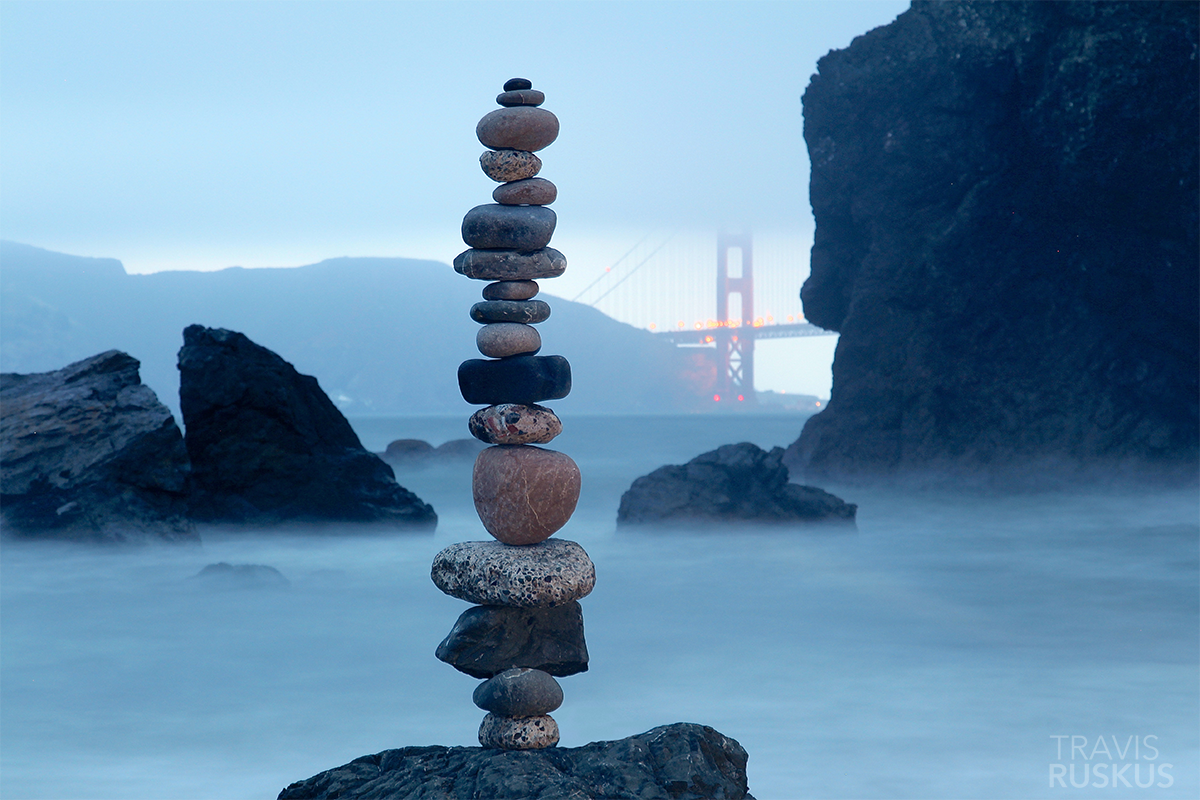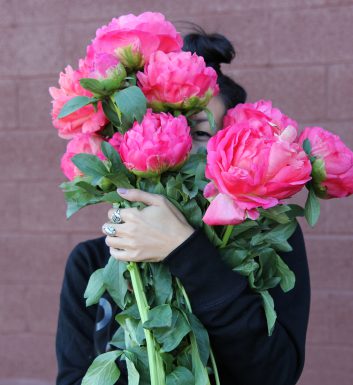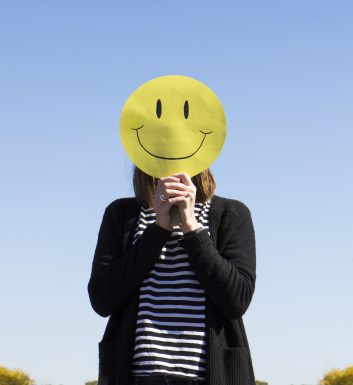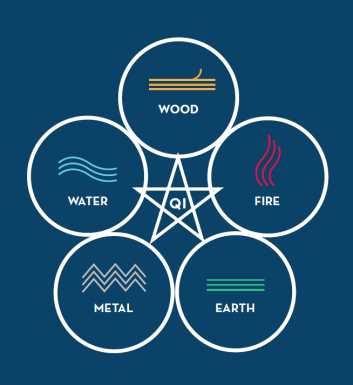
To achieve balance in life, start with rocks
For real.
When 26-year-old San Francisco-based Travis Ruskus’ art fails (or falls), the result is always the same – a pile of rocks. Be it on a beach on the San Francisco Bay or in a stream outside of Boulder, or next to a body of water on any of the seven continents around the world, Ruskus’ creations take more than a steady hand and creative heart. It takes the patience to defy gravity. While Ruskus’ art exists both in the physical rock sculptures and in photography, his failed art is in fact the way to his next creation.
Ruskus was following in his father’s path, an engineer who works on mapping satellites, but decided instead to try his hand in psychology, then as a chef, studying and working in San Francisco. With a passion for art, it only took getting fired from his last cooking job just four days before Christmas to take his artistic drive to the next level. The pedigree paid off in spades, as his rock formations are a mix of art, mechanical engineering and embedded in-between, the literal psychological stamina to balance boulders on top of stones.
DAO Labs’ co-founder John G. McGarvey stumbled upon Ruskus the way many find his art, by way of his stunning Instagram feed. Inspired first by the creations and then later by the personal narrative behind them, McGarvey spoke with Ruskus about his path to the rocks and the beauty in failing.

JGM: You balance rocks – how did you discover this was possible? How did it all begin?
TR: Initially I went to school for business and art in Colorado. I changed my major three different times – mechanical engineering, then psychology and then cooking. I followed my sister west to San Francisco to attend a culinary school and it was there that I got my teeth cut. It was very rough and hard training, but at the same time I still carry [the lessons] with me to this day. After that, I spent a couple of years working in some really nice kitchens in San Francisco and Portland. It was really, really hard cooking all day long and you can barely get any time to eat yourself. It was through that, that I kind of realized, what do I really want in life and it was during that time I would go home and paint and I would get all that creativity energy. It was just kind of flow out me. Then I got fired from one of my jobs four days before Christmas.
JGM: WHAT?
TR: That was the industry that I was living in. After that, I moved back home – and that was a really tough period. I was 22 and there were people around me that were making money and I thought, why is that not me? So I spent some time, probably 6-8 months, really going all in with painting. But this whole build-up leads to the one moment where I’m standing in a creek in Boulder, just contemplating everything, asking myself, “What do I do?, Who am I”? It was at that moment that I just looked down at the water and the way that the water was just rushing past my feet. It helped to stop thinking so much and just start feeling a little bit more. The water was shallow and slow enough that I was able to see through to see the stones below. The way the sunlight cut through the water really illuminated those stones, they were almost diamond-like. So I just picked up one and thought, how old is this rock? Millions of years? Billions? I was able to take that rock and just truly connect with it – I feel like I was connecting with everything.

JGM: That’s a very real but profound moment. You’ve been fired, you’ve moved back home. And you’ve just had this surreal realization. What then?
TR: It was more of challenging myself and [realizing that] despite all the nasty stuff that had happened that I could still have a voice. I could do something that just was beyond what the limiting beliefs that I had were. So I just found another nice, big huge kind of boulders that was sticking out above the water right beside me, and just tried to balance it in the hardest way possible, like on its nose. And it was after about 45 minutes that I finally stopped to just feel the stone. It was like I kept “thinking it into balance” and it’s like, you know over the years, as I’ve been doing balancing, [I’ve learned] that’s not how you do really good balances.
And when I was able to stop thinking that I could notice how when I moved the stone left or right that it shifted in. I stopped thinking and it took me about probably two minutes and the stone just locked in place and at that moment, I realized that if everybody, if anybody does this on their own, and I highly recommend it because it was just like, it just clicked into place and you just kind of feel it, that you feel this connection with the earth that something on your phone can’t really give you.
JGM: How did you go from balancing two stones in a creek in Boulder to creating these incredible pieces today?
TR: I was just going out there doing it for myself. It helped me while I was still painting. And it was also helping me work through this sticking point of life. It’s hard to make a completely original idea and when I hit those sticking points, I just would come to the creek and get my head clear and balance some rocks. And after a while, I thought that I should just take a couple of pictures or do a little video and I share them my friends.
JGM: What would be their feedback?
TR: They would say, “that’s not real!” It’s still funny to me because I thought, “I just took the photo of it, how could it not be real?”
JGM: From Boulder to now?
TR: It was almost this natural progression with myself where I couldn’t do the same balance twice. And still to this day, I still can’t do the same balance twice. And so what happened is part B of my story, how this momentum got built, as I started doing these balances, more and more people started to come up to the side of the river and just stop, really sharing the moment with me. They were just awestruck. It was so nice to get someone not easily brushing something off the way we live.

JGM: You must have a fair share of failure – working on something for hours and then have it come crashing down. Can you shed some light on what that feels like?
TR: Failure is probably the most essential part of anything. The thing about the stones is they’re a metaphor. They’re a metaphor for whatever vision you want to achieve. The reason why this is so amazing is because when a lot of people see a pile of rocks, they just kind of discard them, but I see possibility. And when you can translate that into other areas such as when I taught a five-year-old to balance a rock and how to push past the limiting beliefs, as she’s failing and failing, imagine what she can do in her classroom when kids bully her and she realizes, screw you. Or pushing past the teacher who gives her an F? That’s the things you can learn to move past. It’s really a great metaphor.
JGM: Failing is a step in the creative process, but one that you recognize right away?
TR: A great quote summarizes it nicely, “Failure is the test to see how much you truly believe”. And especially in this world of “push button, instant gratification”, people just want the short cut. They just want to instantly get the results and as soon as they encounter failure, they give up. These are the types of trials that I’ve been put through to see if I really wanted it.
“Failure is the test to see how much you truly believe”
JGM: The actual stacks themselves – you’ve just completed a stack that might last mere seconds before toppling down or could last days. But that’s just part of your art. You then have to photograph it. How does that work?
TR: This isn’t just me casually taking an iPhone picture. It’s me going out to a specific spot to create a work of art. For example, piece number “119” the rocks kind of locked into place. It was really quick and nice and it was up for two hours. I was able to let the sun do its magic and I was taking photograph as I went along, just stopping to enjoy everything.
JGM: You title your art numerically and chronologically, with each piece appearing more complicated than the one before it. Is there a limit to how far you can push this art?
TR: There are infinite possibilities. You go above what you think you can do. I remember a moment where I was painting and realizing the blank canvass is the hardest. There are so many possibilities that you can do with it. How do you make that first brush stroke that defines where to step in – I kind of feel limited in that sense?

JGM: This process is very meditative for you. There’s a peacefulness to it.
TR: When I’m having stressful moments where things aren’t falling into place, those true defining moments where I need to find that clarity – usually when I find that clarity I’m able to get that balance. It’s finding the clarity in the chaos.
“It’s finding the clarity in the chaos”
JGM: You also teach people how to balance rocks – from elementary classes to the very old. As you teach, what affect does a successful balance of two simple rocks have on them?
TR: It’s just that ability to do something that they thought they couldn’t do. You know it’s nice because it’s a little bit easier than running a marathon or training to run a marathon, you just pick up the rock and balance it. But that feeling and expression – it’s something where in that five-year old and the 95-year old, they have the same exact look in their eye when they balance that rock for the first time. It transcends age, color, like religion, it is just the coolest thing ever.
JGM: You’re young, knowledgeable, grounded and self -aware. What’s next?
TR: With me as an artist, I’m not Van Gogh and I’m not Picasso. But I share the same energy that they had. It’s really important to just enjoy that moment wherever you are and know that even as you are in the process of getting to where you want to be, you’re already there in that moment. I just think it’s so powerful.
Information about Travis Ruskus, his art, and a step-by-step guide to balance rocks while opening and balancing your heart and mind can be found at http://www.travisruskus.com or on his Instagram feed, @travisruskus.
All images Copyright Travis Ruskus.
Portions of this interview have been edited for length.











